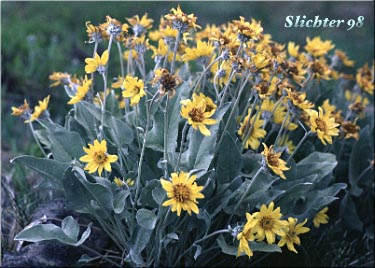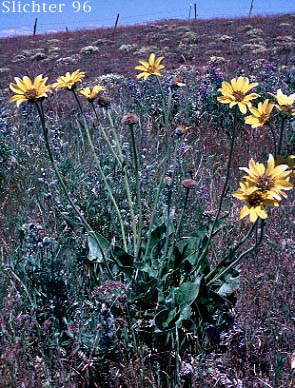Arrowleaf Balsamroot, Arrow-leaf Balsamroot
Balsamorhiza sagittata


 The photo at right shows
arrow-leaf balsamroot as seen atop the Columbia Hills to the north of The Dalles,
OR........late May, 1996.
The photo at right shows
arrow-leaf balsamroot as seen atop the Columbia Hills to the north of The Dalles,
OR........late May, 1996.
Arrowleaf balsamroot is a widespread perennial arising from a deep, woody taproot. The leaves are numerous, primarily in a basal rosette. The arrowhead leaves are somewhat woolly or felt-like on both sides of the leaf. The wooliness of the leaves seems to be rather variable, as evidenced by the photos on this page. Younger leaves tend to be more silvery (see photo below), with older leaves appearing greener and more glabrate in age. The leaf margins are entire (smooth). The basal leaves are long-petioled with cordate leaf bases. They are up to to 30 cm long and 15 cm wide.
The stems are few to numerous, ranging from 20-80 cm tall. They usually have several very reduced, narrow leaves on the stems. The flower heads tend to be solitary. The heads are large (10-12 cm wide) with 8-25 yellow rays (most commonly either 13 or 21) surrounding a darker disk. The rays are individually about 2.5-4 cm long. The involucre is fairly woolly-hairy. The involucral bracts are long and narrow, with outer ones slightly longer than the inner.
Open hillsides and flats, usually in deep, well-drained soil, typically with big sagebrush or bunchgrass or in open woods.
From southern British Columbia, mostly east of the Cascades south to east-central California, east to Alberta and northern Arizona.
In the Columbia River Gorge, arrowleaf balsamroot is found east of Lyle, WA, between the elevations of 100'-3000'. It blooms from early April to early June.
Balsamroots get their name from the aroma of the root (like balsam). It is a valuable forage for deer, elk, bighorn sheep, and domestic sheep, especially during the spring when the leaves are more succulent. Horses have been known to eat the flowers.
The entire plant is edible to humans. The leaves and shoots may be eaten raw in salads (springtime) or boiled or cooked. The seeds may be roasted or ground into a flour meal. The roots may be cooked for consumption. The Nez Perce peeled the flower stalks before blooming to eat like celery. They also mixed ground seeds into fat balls.
Balsamroots are susceptible to prolonged grazing, which can be seen from many roads in the gorge, where non-grazed meadows will show abundant growth (hillsides may appear ablaze with yellow flower heads), while fields on the opposite side of a fence may show sparse bloom! Mild disturbance via grazing or fire increases the balsamroot stand, as the woody rootstock is able to survive. Evidently, it shows a tendency to produce much seed the 2nd year after a fire.